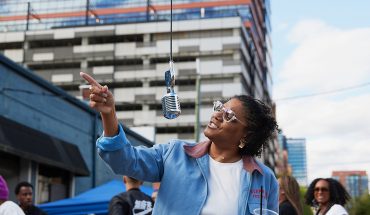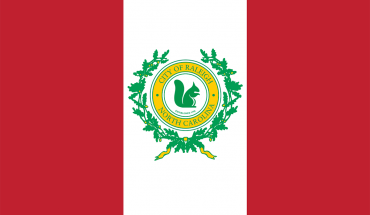
by Marjorie Hodges
The phenomenon known as Burning Man began on the summer solstice in 1986, when artist Larry Harvey erected an eight-foot tall wooden sculpture of a man on a beach in northern California, then gathered friends to watch it burn. From those humble roots, Burning Man has morphed into a global event that attracts more than 70,000 people every year.
The site has also shifted, to the vast Black Rock desert, about 120 miles north of Reno, Nevada. For a few days, seven square miles of an ancient former lakebed, now known as the Playa, transform into Black Rock City (BRC), the temporary home of Burning Man. There, a community of artists, technologists and designers collaborate to create a public space filled with art, contemporary culture, music, merriment and more. Last year, a close friend invited me to attend this remarkable event—tickets are difficult to obtain, so I feel privileged that I got to go.
Many people go to Burning Man for the all-night parties and music, but I was drawn by the prospect of seeing nearly 200 large-scale art installations in the Black Rock desert. It’s a totally blank canvas, with miles between each work to breathe. Art and community are my passion, so I hoped to be inspired and bring innovative and collaborative ideas back to North Carolina. Many internationally known artists participate every year, including my friend Hank Willis Thomas, a conceptual artist who works primarily with themes related to identity, history and popular culture. Hank describes Burning Man as “…the most amazing, terrible experience you will ever have. It’s lonely, dusty, hot, you are dehydrated, nothing goes as planned and that’s when it happens: You realize that everything you don’t like about a situation is because you haven’t done enough creatively to change or creatively accept it.”
And so it was that late August 2018,
I dropped my dear daughter off at Emerson College in Boston, Massachusetts, to begin her freshman year, then rushed back to begin the journey to Black Rock City, a place that’s intentionally remote and not “on the way” to anywhere. My friend and I flew to Reno, then boarded the Burner Express, a private air service that operates just once a year, to fly Burners to the Playa. The alternative would have been a three-hour-minimum drive, culminating in a single road entering BRC, with a four- to twelve-hour wait for traffic to enter… so we were grateful for these entrepreneurial folks.
Once on site, the world changed. I’ll admit that, as a brand-new empty-nester, I was feeling a bit emotional as I approached the funky welcome center. They checked me in and immediately required a “dust angel”—so I found myself flat on my back, working my arms and legs through the thick, talc-like dust that is central to the life on the Playa. But getting dusty early was a good idea: it eliminated any thought of staying clean.

A bus ride toward camp revealed the first look at the remarkable “city” built on desert wilderness. Every imaginable form of shelter, from tents to RVs to tarps, serves as home for the tens of thousands of Burners who survive for a week in this completely inhospitable environment. Many of the camps offer “public service” assistance—tax advice, yoga classes, Japanese silk rope bondage techniques—it’s all at Burning Man. All of this without a conventional fee for products or services, as Burning Man is a cashless society. De-commodification is a rule: no money changing hands, no visible logos on clothing, no commercial activity of any kind. The only items you can buy with money are ice and coffee.
Towering above the tents: the art. The scale of each work and the scope of the playa created an other-worldly viewing experience. Thomas’ stunning installation, All Power to All People, was monumental—a 25-foot-tall Afro Pick sculpture to honor and celebrate cultural identities of the African diaspora and symbolize community and comradeship. The metal sculpture was interactive, large enough to climb on (see photo at left). Thomas is known in North Carolina, with multiple works in the North Carolina Museum of Art and Nasher Museum of Art collections, and it was stunning to see his work here, in the desert.
Another noteworthy installation was the ORB. The much-anticipated project by Danish architects Bjarke Ingels and Jakob Lange of Bjarke Ingels Group (BIG) served as a beacon in the desert, both day and night. The 85-foot-diameter inflatable sphere was designed to hover over the Burners, reflecting the expanse of participants and the desert itself. This installation was partially crowdfunded on Indiegogo, where it was described as a “mirror for earth lovers,” at a scale of 1/500,000 of the earth’s surface.
The Long View: a polar bear stands in the desert, by Santa Fe, New Mexico artist Don Kennell, was a surprisingly lifelike 36-foot-tall polar bear, molded from discarded white automobile hoods. The towering sculpture seemed to look across the boundless vista of BRC. This installation was designed to encourage “the long view” as it relates to thoughts on climate change and survival. These three were just a few of the works by emerging artists from all over the world.
Beyond the art, I was inspired by the sense of community. Geographic difficulties, extreme temperatures and an absence of electricity and infrastructure require strong collaboration amongst strangers. The conditions on the Playa were harsh: We wore eye goggles to ward against the frequent dust storms that led to loss of visibility—especially when riding a bicycle—sometimes to the point where I had to stop and take cover. The dust got everywhere. Temperatures soared over 100 degrees during the day, then fell to the 40s or 50s by sunrise. During the evenings, wild fur coats were common. But in the heat of the day, the dress code was, well, anything or nothing, from stylish and sexy to dystopian or bare. These unusual conditions add to the surreal, almost alien experience.

Burning Man was not a vacation, it was a mindshift. The unique and harsh setting, the thousands of fellow Burners living outside of convention, the music and the art were starkly different from my hometown reality. The principles of Burning Man decreed by Harvey in 2004—including inclusion, self-expression and civic responsibility—are intended to be radical, and yet they’re adopted for a week by thousands of humans who have never met. Simple and profound, the experience was a reminder of what we all can do if we make an intention to live creatively, cooperatively and peacefully—even back here in Raleigh.



